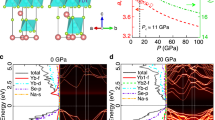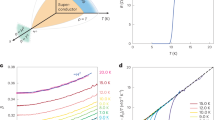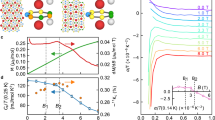Abstract
A long-standing question in the field of superconductivity is whether pairing of electrons can arise in some cases as a result of magnetic interactions instead of electron–phonon-induced interactions as in the conventional Bardeen–Cooper–Schrieffer theory1. A major challenge to the idea of magnetically mediated superconductivity has been the dramatically different behaviour of the cerium and ytterbium heavy-fermion compounds. The cerium-based systems are often found to be superconducting1,2,3,4,5,6, in keeping with a magnetic pairing scenario, but corresponding ytterbium systems, or hole analogues of the cerium systems, are not. Despite searches over two decades there has been no evidence of heavy-fermion superconductivity in an ytterbium system, casting doubt on our understanding of the electron–hole parallelism between the cerium and the ytterbium compounds. Here we present the first empirical evidence that superconductivity is indeed possible in an ytterbium-based heavy-fermion system. In particular, we observe a superconducting transition at Tc=80 mK in high-purity single crystals of YbAlB4 in the new structural β phase7. We also observe a novel type of non-Fermi-liquid state above Tc that arises without chemical doping, in zero applied magnetic field and at ambient pressure, establishing β-YbAlB4 as a unique system showing quantum criticality without external tuning.
This is a preview of subscription content, access via your institution
Access options
Subscribe to this journal
Receive 12 print issues and online access
$259.00 per year
only $21.58 per issue
Buy this article
- Purchase on SpringerLink
- Instant access to full article PDF
Prices may be subject to local taxes which are calculated during checkout




Similar content being viewed by others
Change history
11 July 2008
In the version of this article previously published online, the bottom right inset of Fig. 1b, was missing its data. The figure has now been corrected in the HTML and pdf versions, and it will appear correctly in the print version.
References
Monthoux, P., Pines, D. & Lonzarich, G. G. Superconductivity without phonons. Nature 450, 1177–1183 (2007).
Mathur, N. D. et al. Magnetically mediated superconductivity in heavy fermion compounds. Nature 394, 39–43 (1998).
Stewart, G. R. Non-Fermi-liquid behaviour in d- and f-electron metals. Rev. Mod. Phys. 73, 797–855 (2001).
Yuan, H. Q. et al. Observation of two distinct superconducting phases in CeCu2Si2 . Science 302, 2104–2107 (2003).
Löhneysen, H. v., Rosch, A., Vojta, M. & Wölfle, P. Fermi-liquid instabilities at magnetic quantum phase transitions. Rev. Mod. Phys. 79, 1015–1075 (2007).
Gegenwart, P., Si, Q. & Steglich, F. Quantum criticality in heavy-fermion metals. Nature Phys. 4, 186–197 (2008).
Macaluso, R. T. et al. Crystal structure and physical properties of polymorphs of LnAlB4 (Ln=Yb,Lu). Chem. Mater. 19, 1918–1922 (2007).
Fisk, Z., Yang, K. N., Maple, M. B. & Ott, H. R. in Valence Fluctuations in Solids (eds Falicov, L. M., Hanke, W. & Maple, M. B.) 345–347 (North-Holland, New York, 1981).
Kadowaki, K. & Woods, S. B. Universal relationship of the resistivity and specific heat in heavy-Fermion compounds. Solid State Commun. 58, 507–509 (1986).
Moriya, T. Spin Fluctuations in Itinerant Electron Magnetism (Springer, Berlin, 1985).
Millis, A. J. Effect of a nonzero temperature on quantum critical points in itinerant fermion systems. Phys. Rev. B 48, 7183–7196 (1993).
Coleman, P., Pépin, C., Si, Q. & Ramazashvili, R. How do Fermi liquids get heavy and die? J. Phys. Condens. Matter 13, R723–R738 (2001).
Si, Q., Rabello, S., Ingersent, K. & Smith, J. L. Locally critical quantum phase transitions in strongly correlated metals. Nature 413, 804–808 (2001).
Senthil, T., Sachdev, S. & Vojta, M. Fractionalized Fermi liquids. Phys. Rev. Lett. 90, 216403 (2003).
Löhneysen, H. v. et al. Non-Fermi-liquid behaviour in a heavy-fermion alloy at a magnetic instability. Phys. Rev. Lett. 72, 3262–3265 (1994).
Schröder, A. et al. Onset of antiferromagnetism in heavy-fermion metals. Nature 407, 351–355 (2000).
Trovarelli, O. et al. YbRh2Si2: Pronounced non-Fermi-liquid effects above a low-lying magnetic phase transition. Phys. Rev. Lett. 85, 626–629 (2000).
Custers, J. et al. The break-up of heavy electrons at a quantum critical point. Nature 424, 524–527 (2003).
Gegenwart, P. et al. Multiple energy scales at a quantum critical point. Science 315, 969–971 (2007).
Holmes, A. T., Jaccard, D. & Miyake, K. Signatures of valence fluctuations in CeCu2Si2 under high pressure. Phys. Rev. B 69, 024508 (2004).
Sakakibara, T., Mitamura, H., Tayama, T. & Amitsuka, H. Faraday force magnetometer for high-sensitivity magnetization measurements at very low temperatures and high fields. Japan. J. Appl. Phys. 33, 5067–5072 (1994).
Acknowledgements
We thank M. Ichihara and Y. Kiuchi for their transmission electron microscopy and inductively coupled plasma analyses, and A. Kusmartseva, S. S. Saxena, Y. Matsumoto, T. Tomita, J. Yamaura, Y. Uwatoko, D. Pines, Julia Y. Chan, M. Surtherland, E. O’Farrell, Q. Si, M. Imada and C. Pépin for discussions. This work has been supported in part by Grants-in-Aid for Scientific Research from JSPS, by a Grant-in-Aid for Scientific Research on Priority Areas as well as the 21COE program ‘Diversity and Universality in Physics’ from MEXT of Japan and by the NSF of the United States through DMR-0710492.
Author information
Authors and Affiliations
Corresponding author
Rights and permissions
About this article
Cite this article
Nakatsuji, S., Kuga, K., Machida, Y. et al. Superconductivity and quantum criticality in the heavy-fermion system β-YbAlB4. Nature Phys 4, 603–607 (2008). https://doi.org/10.1038/nphys1002
Received:
Accepted:
Published:
Issue date:
DOI: https://doi.org/10.1038/nphys1002
This article is cited by
-
Prediction of Van Hove singularity systems in ternary borides
npj Computational Materials (2023)
-
Anisotropy-driven quantum criticality in an intermediate valence system
Nature Communications (2022)
-
Mechanism of the insulator-to-metal transition and superconductivity in the spin liquid candidate NaYbSe2 under pressure
npj Quantum Materials (2022)
-
Migration regularities of impurities C, O, Fe, Co and Ni and effect of crystal transition on C, O and Fe in purification of metal La by solid-state electrotransport
Rare Metals (2021)
-
Concomitant singularities of Yb-valence and magnetism at a critical lattice parameter of icosahedral quasicrystals and approximants
Scientific Reports (2020)



